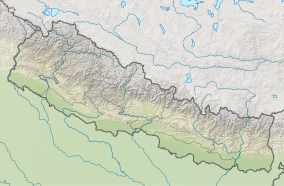Shivapuri Nagarjun National Park
| Shivapuri Nagarjun National Park | |
|---|---|
 View of Shivapuri Nagarjun National Park from Sundarijal | |
| Location | Nepal |
| Nearest city | Kathmandu |
| Coordinates | 27°47′42″N 85°23′24″E / 27.79500°N 85.39000°E |
| Area | 159 km2 (61 sq mi) |
| Established | 2002 |
| Governing body | Department of National Parks and Wildlife Conservation (Nepal) |
 | |
Shivapuri Nagarjun National Park is the ninth national park in
History
The area has always been an important
The park includes some historical and religious sites, and a popular hiking route for local people and tourists.[3]
Climate
The park is located in a transition zone between subtropical and temperate climates. The annual precipitation of about 1,400 mm (55 in) falls mostly from May to September, with 80% during the monsoon. Temperatures vary from 2–17 °C (36–63 °F) during the winter season, rising to 19–30 °C (66–86 °F) during the summer season.
Vegetation

The typical vegetation of the park is middle hill forest from 1,000 to 1,800 m (3,300 to 5,900 ft) of altitude, consisting of:
- chir pine stands on southern dry ridges and associations of alder, wild Himalayan cherry, Engelhardia and ring-cupped oakalong streams;
- Eastern Himalayan broadleaf forests in the lower temperate bioclimatic zone with predominantly broadleaf evergreen species of oak and laurel families mixed with rhododendron on northern slopes.[4][5]
In higher elevations, a variety of medicinal
Fauna


Since 2002 several surveys have been carried out to determine the faunal diversity of the protected area. In a field study carried out from July 2003 to July 2004,
In the western part of the park,
References
- ^ ISBN 978-92-9115-033-5.
- ^ a b c Pandey, B. P. (2010). A report on presence absence survey of clouded leopard (Neofelis nebulosa) in Shivapuri Nagarjun National Park, Nepal (Report). Submitted to Government of Nepal.
- ^ Kunwar, K. J. (2008). "Payment for Environmental Services in Nepal (A Case Study of Shivapuri National Park, Kathmandu, Nepal)". The Initiation. 63: 63–72.
- ^ ISBN 974-89833-5-8. Pages 200–204.
- ^ Sigdel, S.R. (2009). Altitudinally coordinated pattern of plant community structure in the Shivapuri National Park, Nepal. Banko Janakari 18 (1): 11–17.
- ^ Maskey, N. (2008). Investing in Ecosystem Services: Opportunities and Challenges for Shivapuri National Park, Nepal. Lund University Centre for Sustainability Studies, Sweden
- .
- ^ Aryal, P. C., Pokhrel, G. K., Shah, K. B., Rijal, B., Kharel, S. C., Paudel, E., Suwal, M. K., Dhamala, M. K., Bhurtel, B. P. (2010). Inventory of Herpetofaunal Diversity In Nagarjun Forest of Shivapuri Nagarjun National Park. Companions for Amphibians and Reptiles of Nepal, Kathmandu, Nepal.
- ^ Bird Conservation Nepal (2006). Birds of Shivapuri. Checklist of 318 reported species. Published in cooperation with Shivapuri National Park, Kathmandu.
Further reading
- Bird Conservation Nepal (2006). Birds of Shivapuri. Checklist of 318 reported species. Published in cooperation with Shivapuri National Park, Kathmandu.

